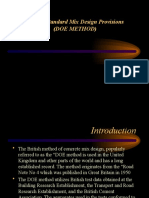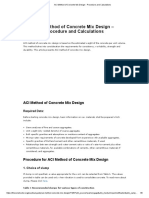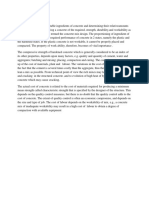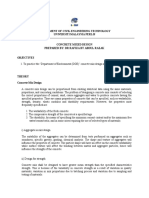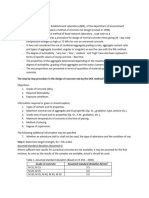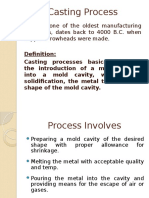Concrete Mix Design Steps
Concrete Mix Design Steps
Uploaded by
Muhammad Mahamudul HasanCopyright:
Available Formats
Concrete Mix Design Steps
Concrete Mix Design Steps
Uploaded by
Muhammad Mahamudul HasanOriginal Description:
Copyright
Available Formats
Share this document
Did you find this document useful?
Is this content inappropriate?
Copyright:
Available Formats
Concrete Mix Design Steps
Concrete Mix Design Steps
Uploaded by
Muhammad Mahamudul HasanCopyright:
Available Formats
Steps of Concrete Mix Design
Concrete mix designs is best defined as a process in selecting suitable ingredients, which is cement, aggregate, sand and water, and determining their relative proportions to give the required strength, workability and durability. The mix designs, which is a performance specification stating required strength and minimum cement content but leaving the grading and details of the concrete mix design to be work out.
Objective of Concrete Mix Design
Two main objectives for concrete mix design:
To determine the proportions of concrete mix constituents of; Cement, Fine aggregate (or normally Sand), Coarse aggregate, and Water. To produce concrete of the specified properties. To produce a satisfactory of end product, such as beam, column or slab as economically as possible.
Theory of Mix Designs
The Process of Concrete Mix Design The method of concrete mix design applied here is in accordance to the method published by the Department of Environment, United Kingdom (in year 1988). There are two categories of initial information required: 1. Specified variables; the values that are usually found in specifications. 2. Additional information, the values normally available from the material supplier. Reference data consists of published figures and tables is required to determine the design values including;
Mix parameters such as target mean strength, water-cement ratio and concrete density. Unit proportions such as the weight of materials.
The design process can be divided into 5 primary stages. Each stage deals with a particular aspect of the concrete mix design:
Stage 1: Determining the Free Water/ Cement Ratio i) Specify the required characteristic strength at a specified age, fc ii) Calculate the margin, M. M = k x s .. [ F1 ] where; k = A value appropriate to the defect percentage permitted below the characteristic strength. [ k = 1.64 for 5 % defect ] s = The standard deviation (obtained from Figure 1).
Figure 1: Approximate compressive strength (N/mm2) of concrete mixes made with a freewater/cement ratio of 0.5 iii) Calculate the target mean strength, fm fm = fc + M .. [ F2 ] where; fm = Target mean strength fc = The specified characteristic strength iv) Given the type of cement and aggregate, use the table of Figure 1 to obtain the compressive strength, at the specified age that corresponds to a free water/cement ratio of 0.5.
Muhammad Mahamudul Hasan
mahamud@live.com
Page
Figure 2: Relationship between compressive strength and free-water/ cement ratio. v) In Figure 2, follow the starting line to locate the curve which passes through the point (the compressive strength for water/cement ratio of 0.5). To obtain the required curve representing the strength, it is necessary to interpolate between the two curves in the figure. At the target mean strength draw horizontal line crossing the curve. From this point the required free water/cement ratio can be determined.
Muhammad Mahamudul Hasan
mahamud@live.com
Page
Stage 2: Determining the Free-Water Content
Figure 3: Approximate free-water contents (kg/m3) required to give various levels of workability. Given the Concrete Slump or Vebe time, determine the free water content from table Figure 3. Stage 3: Determining the Cement Content Cement Content = Free Water Content / Free-water or Cement Ratio .. [ F3 ] The resulting value should be checked against any maximum or minimum value that may be specified. If the calculated cement content from F3 is below a specified minimum, this minimum value must be adopted resulting in a reduced water/cement ratio and hence a higher strength than the target mean strength. If the calculated cement content is higher than a specified maximum, then the specified strength and workability simultaneously be met with the selected materials; try to change the type of cement, the type and maximum size of the aggregate. Stage 4: Determining the Total Aggregate Content This stage required the estimate of the density of fully compacted concrete which is obtained from Figure 4. This value depends upon the free-water content and the relative density of the combined aggregate in the saturated surface-dry condition. If no information is available regarding the relative density of the aggregate, an approximation can be made by assuming a value of 2.6 for un-crushed aggregate and 2.7 for crushed aggregate.
Muhammad Mahamudul Hasan
mahamud@live.com
Page
FIgure 4 : Estimated wet density of fully compacted concrete. With the estimate of the density of the concrete the total aggregate content is calculated using equation F4: Total Aggregate Content = D C W .. [ F4 ] Where; D = The wet density of concrete ( in kg/m3) C = The cement content (in kg/m3) W = The free-water content (in kg/m3) Stage 5: Determining of The Fine and Coarse Aggregate Contents This stage involves deciding how much of the total aggregate should consist of materials smaller than 5 mm, i.e. the sand or fine aggregate content. The Figure 5 shows recommended values for the proportion of fine aggregate depending on the maximum size of aggregate, the workability level, the grading of the fine aggregate (defined by the percentage passing a 600 m sieve) and the free-water/ cement ratio. The best proportion of fines to use in a given concrete mix design will depend on the shape of the particular aggregate, the grading and the usage of the concrete.
Muhammad Mahamudul Hasan
mahamud@live.com
Page
Muhammad Mahamudul Hasan
mahamud@live.com
Page
Figure 5 : Recommended proportions of fine aggregate according to percentage passing a 600 m sieve. The final calculation, equation F5, to determine the fine and coarse aggregate is made using the proportion of fine aggregate obtained from Figure 5 and the total aggregate content derived from Stage 4. Fine Aggregate Content = Total Aggregate Content x Proportion of Fines .. [ F5 ] Coarse Aggregate Content = Total Aggregate Content Fine Aggregate
Procedures of Design Mixing
Production of Trial Mix Design 1. The volume of mix, which needs to make three cubes of size 100 mm is calculated. The volume of mix is sufficient to produce 3 numbers of cube and to carry out the concrete slump test. 2. The volume of mix is multiplied with the constituent contents obtained from the concrete mix design process to get the batch weights for the trial mix. 3. The mixing of concrete is according to the procedures given in laboratory guidelines. 4. Firstly, cement, fine and course aggregate are mixed in a mixer for 1 minute. 5. Then, water added and the cement, fine and course aggregate and water mixed approximately for another 1 minute. 6. When the mix is ready, the tests on mix are proceeding.
Slump Test apparatus for Concrete Workability
Muhammad Mahamudul Hasan
mahamud@live.com
Page
Tests on Trial Mix Design 1. The slump tests are conducted to determine the workability of fresh concrete. 2. Concrete is placed and compacted in three layers by a tamping rod with 25 times, in a firmly held slump cone. On the removal of the cone, the difference in height between the uppermost part of the slumped concrete and the upturned cone is recorded in mm as the slump. 3. Three cubes are prepared in 100 mm x 100 mm each. The cubes are cured before testing. The procedures for making and curing are as given in laboratory guidelines. Thinly coat the interior surfaces of the assembled mould with mould oil to prevent adhesion of concrete. Each mould filled with two layers of concrete, each layer tamped 25 times with a 25 mm square steel rod. The top surface finished with a trowel and the date of manufacturing is recorded in the surface of the concrete. The cubes are stored undisturbed for 24 hours at a temperature of 18 to 220C and a relative humidity of not less than 90 %. The concrete all are covered with wet gunny sacks. After 24 hours, the mould is striped and the cubes are cured further by immersing them in water at temperature 19 to 21oC until the testing date. 4. Compressive strength tests are conducted on the cubes at the age of 7 days. Then, the mean compressive strengths are calculated.
The Calculations
Here is one example of calculation from one of the concrete mix design obtained from the laboratory. We have to fill in all particulars in the concrete mix design form with some calculations
Figure 6 : Relationship between standard deviation and characteristic strength.
Muhammad Mahamudul Hasan
mahamud@live.com
Page
Firstly, we specified 30 N/mm2 at 7 days for the characteristic strength. Then, we obtained the standard deviation, s from the Figure 6. So, s = 8 N/mm2. From the formula F1, k = 1.64 for 5 % defect. The margin, M is calculated as below: M = k x s = 1.64 x 8 = 13.12 N/mm2 With the formula F2, target mean strength, fm is calculated as below: Target mean strength, fm = fc + M = 30 + 13.12 = 43.12 N/mm2 The type of cement is Ordinary Portland Cement (OPC). For the fine and course aggregate, the laboratorys fine aggregate is un-crushed and for coarse aggregate is crushed before producing concrete. Then, we obtain the free-water/ cement ratio from table Figure 1. For OPC ( 7 days ) using crushed aggregate, water/cement ratio = 36 N/mm2. After that, from the Figure 2, the curve for 42 N/mm2 at 0.5 free-water ratio is plotted and obtained the free-water ratio is 0.45 at the target mean strength 43.12 N/mm2. Next, we specified the slump test for slump about 20 mm and the maximum aggregate size we used in laboratory is 10 mm. For the specified above, we can obtained the free-water content from table Figure 3 at slump 10 30 mm and maximum size aggregate 10 mm, the approximate free-water content for the un-crushed aggregates is 180 kg/m3 and for the crushed aggregates is 205 kg/m3. Because of the coarse and fine aggregates of different types are used, the free-water content is estimated by the expression: Free-water Content, W = 2/3 Wf + 1/3 Wc = (2/3 x 180) + (1/3 x 205) = 188.33 kg/m3 where, Wf = Free-water content appropriate to type of fine aggregate Wc = Free-water content appropriate to type of coarse aggregate Cement content also can obtained from the calculation with the expression at F3: Cement Content, C = Free Water Content / Free-water or Cement Ratio = 188.33 / 0.45 = 418.52 kg/m3 We assumed that the relative density of aggregate (SDD) is 2.7. Then, from Figure 4 with the free-water content 188.33 kg/m3, obtained that concrete density is 2450 kg/m3. The total aggregate content can be calculated by: Total Aggregate Content = D C W = 2450 418.52 188.33 = 1843.15 kg/m3
Muhammad Mahamudul Hasan
mahamud@live.com
Page
The percentage passing 600 m sieve for the grading of fine aggregate is about 60 %. The proportion of the fine aggregate can be obtained from the Figure 5, which is 38 %. Then, the fine and course aggregate content can be obtained by calculation: Fine Aggregate Content = Total Aggregate Content x Proportion of Fines = 1868.74 x 0.38 = 700.40 kg/m3 Coarse Aggregate Content = Total Aggregate Content Fine Aggregate = 1843.15 700.40 = 1142.75 kg/m3 The quantity per m3 can be obtained, which is; Cement = 418.52 kg Water = 188.33 kg Fine aggregate = 700.40 kg Coarse aggregate (10 mm) = 1142.75 kg The volume of trial mix for 3 cubes = [(0.1 x 0.1 x 0.1) x 3] + [25% contingencies of trial mix volume] = 0.006 + 0.00075 = 0.00375 m3 The quantities of trial mix = 0.00375 m3, in which is; Cement = 1.57 kg Water = 0.71 kg Fine aggregate = 2.61 kg Coarse aggregate (10 mm) = 4.29 kg
The Results of Mix Design Slump Test = True Slump of 55 mm All the 3 concrete cubes produced were then cured for 7 days. After that, the compressive cube test is carried out. The results are as follows: Sample 1 2 3 Compressive Strength 32.37 33.54 35.70 Average (32.37 + 33.54 + 35.70) / 3 = 33.87 For cubes after 7 days of curing, compressive strength should not be less than 2/3 target mean strength. = 2/3 43.12 = 28.75 N/mm2 < 33.9 N/mm2 After 7 days of curing, the compressive strength of concrete cubes produced by the mix design method pass the specific strength requirements.
Muhammad Mahamudul Hasan
mahamud@live.com
Page
10
Discussions Upon Concrete Mix Designs
Although our compressive strength passes the specific requirements, we still identified several factors which contribute to the lacking of compressive strength of concrete mixes produced in the experiment. However, the main factor is the condition of aggregates whether it is exposed to sunlight or rainfall. When the free water/cement ration is high, workability of concrete is improved. However, excessive water causes honey-comb effect in the concrete produced. The concrete cubes become porous, and hence its compressive strength is well below the design value. Other possible reasons include over compaction, improper mixing methods and some calculation errors. Few suggestion upon several steps to avoid the problems previously faced:
All the raw materials, which is cement, aggregates, and sand should be protected from precipitation or other elements which may affect its physical properties. The quantity of ingredients may be adjusted if necessary, theoretical values are not always suitable. For example, if the aggregates are wet or saturated, less amount of water should be added, vice versa. Compaction should be done carefully, as either under or over-compaction will bring significant negative effect on the concrete produced.
The Conclusion
1. By using the concrete mix design method, we have calculated the quantities of all ingredients, that is water, cement, fine and coarse aggregate according to specified proportion. 2. The concrete produced did not fulfill the compressive strength requirements due to several reasons. Furthermore, some steps mentioned above should be taken into consideration to overcome this problem. Standard reference for the concrete mix design is as accordance to British Standard; BS 5328: 1981 : Methods of Specifying Concrete including Ready-Mixed Concrete
Muhammad Mahamudul Hasan
mahamud@live.com
Page
11
You might also like
- Bs - Concrete Mix Design DoeDocument9 pagesBs - Concrete Mix Design DoePranav Tarlekar100% (4)
- Rajuk FAR & MGCDocument1 pageRajuk FAR & MGCMuhammad Mahamudul Hasan85% (40)
- Steps of Concrete Mix Design BSDocument11 pagesSteps of Concrete Mix Design BSAlhilali Ziyad78% (9)
- Bs Mix Design Doe MethodDocument22 pagesBs Mix Design Doe Methodsanthu25693% (27)
- C40 Concrete Mix DesignDocument2 pagesC40 Concrete Mix DesignIsaiahogeda67% (3)
- Objective of Concrete Mix DesignDocument11 pagesObjective of Concrete Mix DesignJude Prasanna0% (1)
- MRP Passport Form (Bangladesh Form)Document4 pagesMRP Passport Form (Bangladesh Form)Muhibbul Muktadir Tanim67% (3)
- MRP Passport Form (Bangladesh Form)Document4 pagesMRP Passport Form (Bangladesh Form)Muhibbul Muktadir Tanim67% (3)
- Design & Make Fashion Bags & PursesDocument161 pagesDesign & Make Fashion Bags & PursesTimea Tasnadi100% (18)
- Making DollsDocument79 pagesMaking Dollspantheresq93% (14)
- SikaTop Seal-107 2011-10 - 1Document4 pagesSikaTop Seal-107 2011-10 - 1hanifNo ratings yet
- Concrete Full ReportDocument54 pagesConcrete Full ReportLingChiann玲倩100% (1)
- Concrete Mix DesignDocument36 pagesConcrete Mix Designamitbd80% (5)
- Intro To Concrete Mix DesignDocument118 pagesIntro To Concrete Mix DesignM HAFEEZ RAJA100% (7)
- 3.3 Road Note No. 4-1Document40 pages3.3 Road Note No. 4-1Asad Choudhary100% (1)
- CONCRETE MIX DESIGN LectureDocument32 pagesCONCRETE MIX DESIGN LectureMichael Murillo BaraquioNo ratings yet
- ACI Method of Concrete Mix Design - Procedure and CalculationsDocument8 pagesACI Method of Concrete Mix Design - Procedure and Calculationsvenkateswara rao pothinaNo ratings yet
- Tests For Workability of ConcreteDocument5 pagesTests For Workability of Concretelsatchithananthan100% (1)
- Concrete Mix DesignDocument7 pagesConcrete Mix DesignChathura ChamikaraNo ratings yet
- Slump TestDocument10 pagesSlump TestLuqma Illieana87% (15)
- DOE Method of Mix DesignDocument5 pagesDOE Method of Mix DesignleorNo ratings yet
- Concrete Mix DesignDocument49 pagesConcrete Mix Designankit100% (4)
- Concrete Mix DesignDocument60 pagesConcrete Mix DesignIrshad Khan100% (2)
- Compressive Strength of ConcreteDocument9 pagesCompressive Strength of ConcreteAmos kipruto100% (1)
- Codes Standards For On Site Testing LaboratoryDocument7 pagesCodes Standards For On Site Testing LaboratoryVipin Kumar ParasharNo ratings yet
- Concrete Mix Design CalculationDocument7 pagesConcrete Mix Design CalculationEmmanuel Mends Fynn100% (1)
- Concrete Mix Design Calculation For M20Document25 pagesConcrete Mix Design Calculation For M20Kosygin Leishangthem100% (5)
- Strength of Concrete Cubes and CylindersDocument6 pagesStrength of Concrete Cubes and CylindersZiyad12100% (2)
- Mix Design Method For Asphalt Concrete PavementDocument16 pagesMix Design Method For Asphalt Concrete PavementElumalai Srinivasan100% (1)
- Water-Cement RatioDocument17 pagesWater-Cement RatioShazwanShahNo ratings yet
- Concret Mix Design (M10 To M100)Document65 pagesConcret Mix Design (M10 To M100)Rajesh Kollipara88% (16)
- Ds - Concrete Mix DesignDocument51 pagesDs - Concrete Mix DesignDarshan ShahNo ratings yet
- Concrete Mix DesignDocument6 pagesConcrete Mix Designyc safety100% (1)
- Mix Design of ConcreteDocument41 pagesMix Design of ConcreteBijay Krishna Das92% (13)
- Concrete TechnologyDocument118 pagesConcrete Technologyeskinderm100% (30)
- How To Use Soil Stabilization In Road ConstructionFrom EverandHow To Use Soil Stabilization In Road ConstructionRating: 4 out of 5 stars4/5 (1)
- Concrete Mix DesignDocument20 pagesConcrete Mix DesignRony BaloyiNo ratings yet
- Steps of Concrete Mix Design BSDocument11 pagesSteps of Concrete Mix Design BSrahul.frnds1448100% (1)
- Concrete Mix Design ProcedureDocument10 pagesConcrete Mix Design ProcedureIsaack MalyambareNo ratings yet
- Concrete Mixed Design Method (BS Method)Document11 pagesConcrete Mixed Design Method (BS Method)CocoNo ratings yet
- Objective of Concrete Mix DesignDocument10 pagesObjective of Concrete Mix Designutachi93100% (1)
- Job Mix FormulaDocument12 pagesJob Mix FormulaAnonymous ptLRLiNN0% (1)
- Steps of Concrete Mix DesignDocument11 pagesSteps of Concrete Mix DesignKok Kean YoongNo ratings yet
- Concrete Mixed Design MethodDocument11 pagesConcrete Mixed Design Methodabdicasis rashidNo ratings yet
- ACI Job MixDocument31 pagesACI Job MixIrfan KhanNo ratings yet
- Concrete Mix Design DOE PDFDocument15 pagesConcrete Mix Design DOE PDFkarthiksamp100% (2)
- Concrete Mix Design (Notes) PDFDocument11 pagesConcrete Mix Design (Notes) PDFMohamad Khaled Nordin100% (2)
- Mix DesignDocument5 pagesMix Designsuman subediNo ratings yet
- 11 Chapter 2h - Concrete Mix Design PDFDocument11 pages11 Chapter 2h - Concrete Mix Design PDFCarles FauzanNo ratings yet
- Module V - 2023Document49 pagesModule V - 2023-黄柏威No ratings yet
- Hoy-Kaab Construction CompanyDocument39 pagesHoy-Kaab Construction Companyabdicasis rashidNo ratings yet
- Project On Concrete Mix Design For Various Grades of ConcreteDocument22 pagesProject On Concrete Mix Design For Various Grades of ConcreteMohammad Rizwan KhanNo ratings yet
- Concrete Technology Chapter 4 - Concrete Mix Design MethodsDocument56 pagesConcrete Technology Chapter 4 - Concrete Mix Design MethodsYasichalew sefinehNo ratings yet
- 8 DOE mix designDocument33 pages8 DOE mix designkckushal21No ratings yet
- Concrete Mixed Design - Lab Module 20162017Document12 pagesConcrete Mixed Design - Lab Module 20162017Abdul RazakNo ratings yet
- Concrete Mix DesignDocument4 pagesConcrete Mix DesignZakir AliNo ratings yet
- Mix DesignDocument32 pagesMix DesignAan Ade AswinNo ratings yet
- L5A-Concrete Mix Design-British Method-Print1Document4 pagesL5A-Concrete Mix Design-British Method-Print1Suhaib SulaimanNo ratings yet
- Course Name: Materials & Methods of ConstructionDocument33 pagesCourse Name: Materials & Methods of ConstructionKandasamy AsohanNo ratings yet
- Concrete Mix Design Concrete Mix Design: Presentation LayoutDocument28 pagesConcrete Mix Design Concrete Mix Design: Presentation LayoutKris dNo ratings yet
- 2.2 DOE Method of Mix DesignDocument8 pages2.2 DOE Method of Mix Designtiwari.dipesh001No ratings yet
- Concrete Lab Procedure 1Document33 pagesConcrete Lab Procedure 1Lim Shwe WenNo ratings yet
- Concrete Mix Design Using Crushed SandDocument22 pagesConcrete Mix Design Using Crushed SandOlaolu Olalekan50% (2)
- Mix DesignDocument6 pagesMix DesignSwapnika BodapatiNo ratings yet
- Material Test: Mix Design AppendixDocument8 pagesMaterial Test: Mix Design AppendixSheikh BajunaidNo ratings yet
- Exploratory Project 2Document43 pagesExploratory Project 2AMAN GUPTANo ratings yet
- Design Village BuildingDocument1 pageDesign Village BuildingMuhammad Mahamudul HasanNo ratings yet
- Employer: Value of Works As Per B.O.Q - Deduct Retension 5% - Amount PayableDocument1 pageEmployer: Value of Works As Per B.O.Q - Deduct Retension 5% - Amount PayableMuhammad Mahamudul HasanNo ratings yet
- Proposed Landuse Plan of Madaripur Upazila (Rs Mouza)Document1 pageProposed Landuse Plan of Madaripur Upazila (Rs Mouza)Muhammad Mahamudul HasanNo ratings yet
- Proposed Landuse Plan of Madaripur Upazila (Rs Mouza)Document1 pageProposed Landuse Plan of Madaripur Upazila (Rs Mouza)Muhammad Mahamudul HasanNo ratings yet
- Dhaka Imarat Nirman Bidhimala-2008Document142 pagesDhaka Imarat Nirman Bidhimala-2008sazeda67% (3)
- Proposed Landuse Plan of Madaripur Upazila (Rs Mouza)Document1 pageProposed Landuse Plan of Madaripur Upazila (Rs Mouza)Muhammad Mahamudul HasanNo ratings yet
- Technical Data: Microcrystalline Silica FillersDocument2 pagesTechnical Data: Microcrystalline Silica FillerszulemaNo ratings yet
- Siback - Fiberglass Weld Backing TapeDocument3 pagesSiback - Fiberglass Weld Backing TapeDhaneshwar PatilNo ratings yet
- Mechanics of Composite Materials - Autar K Kaw - 2E - Chap1Document72 pagesMechanics of Composite Materials - Autar K Kaw - 2E - Chap1asderbva0% (1)
- Physical and Mechanical Properties of ConcreteDocument5 pagesPhysical and Mechanical Properties of ConcreteInternational Journal of Research in Engineering and TechnologyNo ratings yet
- Tim Doherty MMC & Eco BuildingDocument33 pagesTim Doherty MMC & Eco BuildingShahbaz ShahNo ratings yet
- Centrifugal CastingDocument4 pagesCentrifugal CastingaerovinuNo ratings yet
- SOR 2012-13 - Part-I& Part-IVDocument148 pagesSOR 2012-13 - Part-I& Part-IVkarri1963No ratings yet
- Nontraditional Machining and Thermal Cutting ProcessesDocument26 pagesNontraditional Machining and Thermal Cutting ProcessesanilmechNo ratings yet
- De Cambio... : Lista de Precios - Sika ConstrucciónDocument3 pagesDe Cambio... : Lista de Precios - Sika ConstrucciónEsteban GonzalezNo ratings yet
- Mineral Trioxide AggregateDocument9 pagesMineral Trioxide AggregateFoysal SirazeeNo ratings yet
- Marshall ReportDocument12 pagesMarshall ReportZulfadhli Zullkeply100% (1)
- Composite Technologies BrochureDocument9 pagesComposite Technologies BrochureyigitilgazNo ratings yet
- Construction and QC in Rigid Pavements For Low Volume Rural Roads by D.V.Bhavanna RaoDocument111 pagesConstruction and QC in Rigid Pavements For Low Volume Rural Roads by D.V.Bhavanna Raoapncrmptpqa100% (1)
- Sustainability in Steel ConstructionDocument5 pagesSustainability in Steel ConstructionIshwarya SrikanthNo ratings yet
- Metal Powder Processing TechniquesDocument26 pagesMetal Powder Processing TechniquesAzhar Ali0% (1)
- Slip AdhesivosDocument24 pagesSlip AdhesivosMiguelAngelPerezEsparza100% (3)
- Lecture 27 PDFDocument4 pagesLecture 27 PDFBhavesh Dilip ChanchlaniNo ratings yet
- Asme P NumberDocument2 pagesAsme P Numbersandesh_honraoNo ratings yet
- Giacoqest 0164en-General CatalogueDocument32 pagesGiacoqest 0164en-General CatalogueMartin CervasioNo ratings yet
- Cvs 02350Document14 pagesCvs 02350WNo ratings yet
- Catalog LDT GeneralDocument60 pagesCatalog LDT GeneralLaurentiu DumitruNo ratings yet
- Exposure Effect of Mgso4 and HCL On Strength Properties of Ceramic Waste Powder by Partial Replacement With CementDocument8 pagesExposure Effect of Mgso4 and HCL On Strength Properties of Ceramic Waste Powder by Partial Replacement With CementIJIRSTNo ratings yet
- Material Teknik Part 1Document35 pagesMaterial Teknik Part 1MuhammadZakyMubarokNo ratings yet
- E34000 Series - Hurricane Impact 1-5/16" Non-Thermal Flush GlazeDocument3 pagesE34000 Series - Hurricane Impact 1-5/16" Non-Thermal Flush GlazeraptorebooksNo ratings yet
- Nexus 07202015Document2 pagesNexus 07202015acas35No ratings yet
- Introduction To Casting ProcessDocument11 pagesIntroduction To Casting ProcessMuraliMohan0% (1)



